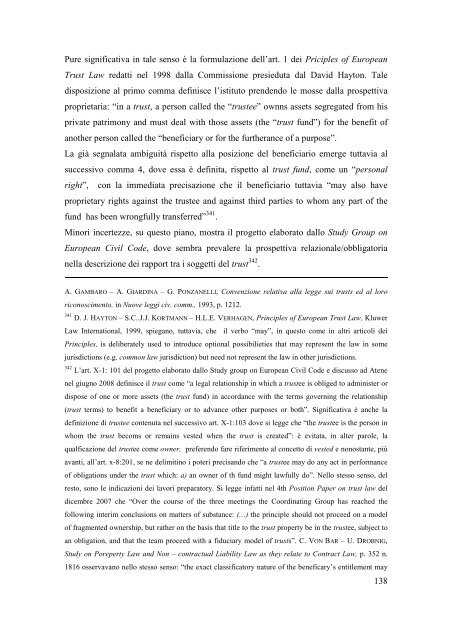“SEPARAZIONE PATRIMONIALE E AUTONOMIA PRIVATA”
“SEPARAZIONE PATRIMONIALE E AUTONOMIA PRIVATA”
“SEPARAZIONE PATRIMONIALE E AUTONOMIA PRIVATA”
You also want an ePaper? Increase the reach of your titles
YUMPU automatically turns print PDFs into web optimized ePapers that Google loves.
Pure significativa in tale senso è la formulazione dell’art. 1 dei Priciples of European<br />
Trust Law redatti nel 1998 dalla Commissione presieduta dal David Hayton. Tale<br />
disposizione al primo comma definisce l’istituto prendendo le mosse dalla prospettiva<br />
proprietaria: “in a trust, a person called the “trustee” ownns assets segregated from his<br />
private patrimony and must deal with those assets (the “trust fund”) for the benefit of<br />
another person called the “beneficiary or for the furtherance of a purpose”.<br />
La già segnalata ambiguità rispetto alla posizione del beneficiario emerge tuttavia al<br />
successivo comma 4, dove essa è definita, rispetto al trust fund, come un “personal<br />
right”, con la immediata precisazione che il beneficiario tuttavia “may also have<br />
proprietary rights against the trustee and against third parties to whom any part of the<br />
fund has been wrongfully transferred” 341 .<br />
Minori incertezze, su questo piano, mostra il progetto elaborato dallo Study Group on<br />
European Civil Code, dove sembra prevalere la prospettiva relazionale/obbligatoria<br />
nella descrizione dei rapport tra i soggetti del trust 342 .<br />
A. GAMBARO – A. GIARDINA – G. PONZANELLI, Convenzione relativa alla legge sui trusts ed al loro<br />
riconoscimento, in Nuove leggi civ. comm., 1993, p. 1212.<br />
341 D. J. HAYTON – S.C..J.J. KORTMANN – H.L.E. VERHAGEN, Principles of European Trust Law, Kluwer<br />
Law International, 1999, spiegano, tuttavia, che il verbo “may”, in questo come in altri articoli dei<br />
Principles, is deliberately used to introduce optional possibilieties that may represent the law in some<br />
jurisdictions (e.g. common law jurisdiction) but need not represent the law in other jurisdictions.<br />
342 L’art. X-1: 101 del progetto elaborato dallo Study group on European Civil Code e discusso ad Atene<br />
nel giugno 2008 definisce il trust come “a legal relationship in which a trustee is obliged to administer or<br />
dispose of one or more assets (the trust fund) in accordance with the terms governing the relationship<br />
(trust terms) to benefit a beneficiary or to advance other purposes or both”. Significativa è anche la<br />
definizione di trustee contenuta nel successivo art. X-1:103 dove si legge che “the trustee is the person in<br />
whom the trust becoms or remains vested when the trust is created”: è evitata, in alter parole, la<br />
qualficazione del trustee come owner, preferendo fare riferimento al concetto di vested e nonostante, più<br />
avanti, all’art. x-8:201, se ne delimitino i poteri precisando che “a trustee may do any act in performance<br />
of obligations under the trust which: a) an owner of th fund might lawfully do”. Nello stesso senso, del<br />
resto, sono le indicazioni dei lavori preparatory. Si legge infatti nel 4th Position Paper on trust law del<br />
dicembre 2007 che “Over the course of the three meetings the Coordinating Group has reached the<br />
following interim conclusions on matters of substance: (…) the principle should not proceed on a model<br />
of fragmented ownership, but rather on the basis that title to the trust property be in the trustee, subject to<br />
an obligation, and that the team proceed with a fiduciary model of trusts”. C. VON BAR – U. DROBNIG,<br />
Study on Poreperty Law and Non – contractual Liability Law as they relate to Contract Law, p. 352 n.<br />
1816 osservavano nello stesso senso: “the exact classificatory nature of the beneficary’s entitlement may<br />
138
















